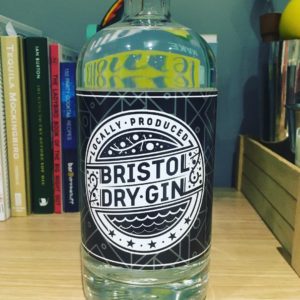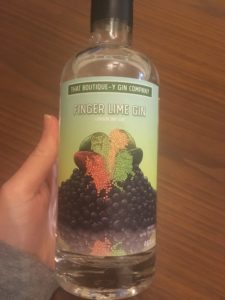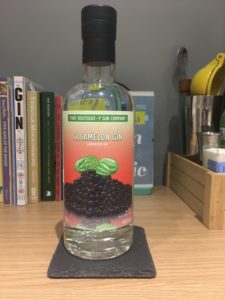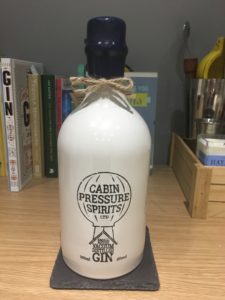 Have you ever had the discussion about “what makes a craft gin, craft”? For me, there are many factors but I’m also interested in the story and the dedication to the gin. Smeaton’s gin is one of those such gins. They use the “Bristol method” which involves distilling each botanical separately, and each batch of distillates varies in maceration length and temperature of distillation to ensure that the very best flavours are achieved. They base their gin on a recipe from 1870 and use eight botanicals, usual suspects juniper, coriander, orange, orris, angelica and liquorice meet cinnamon and calamus – a plant commonly used to help with stomach ailments. Team Smeaton feel that no garnish is needed for their gin as they invest their time into blended it to the perfect taste so nothing is needed to enhance it. Bold claims, so let’s see how it tastes.
Have you ever had the discussion about “what makes a craft gin, craft”? For me, there are many factors but I’m also interested in the story and the dedication to the gin. Smeaton’s gin is one of those such gins. They use the “Bristol method” which involves distilling each botanical separately, and each batch of distillates varies in maceration length and temperature of distillation to ensure that the very best flavours are achieved. They base their gin on a recipe from 1870 and use eight botanicals, usual suspects juniper, coriander, orange, orris, angelica and liquorice meet cinnamon and calamus – a plant commonly used to help with stomach ailments. Team Smeaton feel that no garnish is needed for their gin as they invest their time into blended it to the perfect taste so nothing is needed to enhance it. Bold claims, so let’s see how it tastes.
gin and tonic
Ginvent 2018 – The Teasmith gin
 Day four is upon us and with that comes The Teasmith gin. Founded in Aberdeenshire, their unique botanical is hand picked tea, which they say gives it a minty, sweet finish. The team behind Teasmith wanted to create a gin which celebrated the area they are from, an ethos that seems to link together the new Scottish distilleries. Did you know that James Taylor from Auchenblae (north east Scotland) was the first man to create a tea plantation in Sri Lanka? Seemingly his work there made the island the tea growing paradise that it is now, and the Teasmith team use loose leaf black Ceylon tea from there. All of that history and tradition is bottled in one of the nicest looking bottles on your shelf. But that aside, how does it taste?
Day four is upon us and with that comes The Teasmith gin. Founded in Aberdeenshire, their unique botanical is hand picked tea, which they say gives it a minty, sweet finish. The team behind Teasmith wanted to create a gin which celebrated the area they are from, an ethos that seems to link together the new Scottish distilleries. Did you know that James Taylor from Auchenblae (north east Scotland) was the first man to create a tea plantation in Sri Lanka? Seemingly his work there made the island the tea growing paradise that it is now, and the Teasmith team use loose leaf black Ceylon tea from there. All of that history and tradition is bottled in one of the nicest looking bottles on your shelf. But that aside, how does it taste?
Ginvent 2018 – Manchester Wild Spirit gin
 It’s day two here on the #ginvent blog and today we are drinking Manchester Wild Spirit gin. I’ve tried Manchester gin before but not this version. The Wild Spirit gin is inspired by the woodland walks around Manchester. Taking their signature gin as a base, they remove the orange and lemon and replace these with the deeper, herbal notes from sage, thyme, lemon balm and a hint of woodland with silver birch. Manchester gin is fairly synonymous with dandelion and burdock, and this stays in this edition to give it a warming note midway through before a crisp finish.
It’s day two here on the #ginvent blog and today we are drinking Manchester Wild Spirit gin. I’ve tried Manchester gin before but not this version. The Wild Spirit gin is inspired by the woodland walks around Manchester. Taking their signature gin as a base, they remove the orange and lemon and replace these with the deeper, herbal notes from sage, thyme, lemon balm and a hint of woodland with silver birch. Manchester gin is fairly synonymous with dandelion and burdock, and this stays in this edition to give it a warming note midway through before a crisp finish.
Ginvent 2018 – 58 Clearly Sloe gin
 IT’S DAY ONE OF GINVENT 2018! Here we go again for a third year running. Sorry liver. To kick things off we are trying If you’ve read my blog for the last two years you might have seen my two previous blogs on 58 Gin – their normal gin here and their navy strength here. In those posts you can learn more about 58 Gin, because today we are looking at their sloe gin, and you’d be forgiven for looking past this bottle to try to find the sloe gin. Sloe gins that we know and love are a rich, deep purple colour. This one? Not so much. Rather than seeping sloe berries in a bottle of gin as per the standard method, the berries are included in the distillation process which apparently allows all the flavour, but none of the colour. So, does it actually taste like a sloe gin?
IT’S DAY ONE OF GINVENT 2018! Here we go again for a third year running. Sorry liver. To kick things off we are trying If you’ve read my blog for the last two years you might have seen my two previous blogs on 58 Gin – their normal gin here and their navy strength here. In those posts you can learn more about 58 Gin, because today we are looking at their sloe gin, and you’d be forgiven for looking past this bottle to try to find the sloe gin. Sloe gins that we know and love are a rich, deep purple colour. This one? Not so much. Rather than seeping sloe berries in a bottle of gin as per the standard method, the berries are included in the distillation process which apparently allows all the flavour, but none of the colour. So, does it actually taste like a sloe gin?
Bristol Dry Gin
 The best thing about having lovely friends combined with a birthday and house warming party is that nice people buy you nice gin. Today’s gin is courtesy of my friend Jo, who lives in Bristol, who gave me a bottle of Bristol Dry Gin. When I last visited her I had spotted it in a bar, but as we had popped in for a snack before afternoon tea, I thought it might be a tad too early for a gin. Launched in 2016, Bristol Dry gin was developed by a group of bartenders under the ethos that they were creating a gin for everyone, not just those that can pay £40+ per bottle. Since 2016, they have expended their range to include a Docker’s Strength (55% so named after the dockers from Bristol), the Turbo Island Edition which is a whopping 75% ABV, and a vodka. Today though we drink their Dry gin which underwent rigorous taste testing at their base in The Rummer Hotel, which historically has a reputation for their pionnering cocktail bar. They keep their botanical list pretty secret, stating only the use of “juniper, citrus and angelica root”, so, let’s see if I’m able to guess any more.
The best thing about having lovely friends combined with a birthday and house warming party is that nice people buy you nice gin. Today’s gin is courtesy of my friend Jo, who lives in Bristol, who gave me a bottle of Bristol Dry Gin. When I last visited her I had spotted it in a bar, but as we had popped in for a snack before afternoon tea, I thought it might be a tad too early for a gin. Launched in 2016, Bristol Dry gin was developed by a group of bartenders under the ethos that they were creating a gin for everyone, not just those that can pay £40+ per bottle. Since 2016, they have expended their range to include a Docker’s Strength (55% so named after the dockers from Bristol), the Turbo Island Edition which is a whopping 75% ABV, and a vodka. Today though we drink their Dry gin which underwent rigorous taste testing at their base in The Rummer Hotel, which historically has a reputation for their pionnering cocktail bar. They keep their botanical list pretty secret, stating only the use of “juniper, citrus and angelica root”, so, let’s see if I’m able to guess any more.
Ginvent 2018 – Tarquin’s Tan Ha Mor gin
 Anyone that knows anything about the Gin Foundry calendars knows that Tarquin’s is ingrained into everything they do. One of the first to be involved with Junipalooza, they have also been featured in every Ginvent calendar since the beginning (you can read about their Cornish Dry, Seadog and British Blackberry). This year is no exception and we get to try a brand new and exclusive gin, the Tan Ha Mor. So what makes this gin unique? Working in collaboration with our favourite Gin Foundry folk, they built two firepits on their local beach and smoked English oak chips with coriander, juniper, pink grapefruit and oranges which had previously been smoked in seawater. These were then left to macerate in their Seadog gin before being bottled at 50.5% ABV – the co-ordinates of the beach they roasted the botanicals on.
Anyone that knows anything about the Gin Foundry calendars knows that Tarquin’s is ingrained into everything they do. One of the first to be involved with Junipalooza, they have also been featured in every Ginvent calendar since the beginning (you can read about their Cornish Dry, Seadog and British Blackberry). This year is no exception and we get to try a brand new and exclusive gin, the Tan Ha Mor. So what makes this gin unique? Working in collaboration with our favourite Gin Foundry folk, they built two firepits on their local beach and smoked English oak chips with coriander, juniper, pink grapefruit and oranges which had previously been smoked in seawater. These were then left to macerate in their Seadog gin before being bottled at 50.5% ABV – the co-ordinates of the beach they roasted the botanicals on.
Gŵyr Pinwydd gin
Note: Siân kindly sent me a bottle of their new gin to try, but as always I will let you know what I really think.

You might have seen my post about Gŵyr‘s first gin (if not, you can catch up here) and today we try their new seasonal offering. What does Pinwydd mean I hear you ask? Well, luckily my Welsh is brilliant (and Siân translated it for me) and I can tell you it means “pine trees”. If you’re as smart as I hope you are, you might have guessed that this gin features pine tips as the new flavour. The pine tips are foraged from North Gower – a very different region to South Gower where the team live and distill. They gathered their ingredients and made up their first batch, which they quickly discovered was “too piney” and after some experimenting they found that pink peppercorns were the answer to balancing the flavours. This gin is the first in what they hope will be a seasonal range showcasing what the region has to offer , and this is the ‘winter’ edition. Other seasonal botanicals include orange pulp, zest and cranberry, on top of their original recipe of juniper, angelica, coriander, orris and lemon zest. So, how piney does this gin really taste?
TBGC Finger Lime Gin
Note: The team at Maverick Drinks sent me a bottle to try, but as always – I’ll let you know what I think.
 That Boutique-y Gin Company have done it again. They’ve found a random new fruit for us all to try. Today is is a finger lime. Finger limes come from Australia and they burst open with caviar-like balls which pop in your mouth (FYI this is not something I am a fan of, I have a strange thing about textures) to release a zesty burst of citrus. There’s some debate around whether a finger lime is actually a citrus fruit – currently it is classed as a “microcitrus” although apparently on a molecular level it is nothing like citrus fruits at all. But anyway. Enough nerdy chat. Let’s drink some gin.
That Boutique-y Gin Company have done it again. They’ve found a random new fruit for us all to try. Today is is a finger lime. Finger limes come from Australia and they burst open with caviar-like balls which pop in your mouth (FYI this is not something I am a fan of, I have a strange thing about textures) to release a zesty burst of citrus. There’s some debate around whether a finger lime is actually a citrus fruit – currently it is classed as a “microcitrus” although apparently on a molecular level it is nothing like citrus fruits at all. But anyway. Enough nerdy chat. Let’s drink some gin.
TBGC Cucamelon gin
Note: The team at Maverick Drinks sent me a bottle of this to try, but as always I will let you know what I think.
 That Boutique-y Gin Company seem to have exploded recently. At first, there were a few collaborations using the unwanted spirits from distilleries. Then a few more. And a few more. Then suddenly they had a massive range including some gins they have made all by themselves. Today we are trying the Cucamelon gin. What is a cucamelon I hear you ask? Basically, it’s a native plant to Mexico and Central America which looks like a mini watermelon, but tastes like a cucumber injected with some lime. Obviously. TBGC distil these whole along with other botanicals to create what they call a “fresh, citrusy drink”. They say this works well as a G&T, but even better as a gimlet or a Cucumber Cooler with watermelon juice and mint leaves.
That Boutique-y Gin Company seem to have exploded recently. At first, there were a few collaborations using the unwanted spirits from distilleries. Then a few more. And a few more. Then suddenly they had a massive range including some gins they have made all by themselves. Today we are trying the Cucamelon gin. What is a cucamelon I hear you ask? Basically, it’s a native plant to Mexico and Central America which looks like a mini watermelon, but tastes like a cucumber injected with some lime. Obviously. TBGC distil these whole along with other botanicals to create what they call a “fresh, citrusy drink”. They say this works well as a G&T, but even better as a gimlet or a Cucumber Cooler with watermelon juice and mint leaves.
Cabin Pressure gin
 We’ve all heard of small batch gin where small teams hand craft their gin and run the whole business from their homes. Cabin Pressure gin is about as small as it can get – a husband and wife team working out of their garden shed in Horsham; indeed when we met David at the Sussex Festival of Gin, his wife was frantically bottling the next batch back home as they didn’t have enough stock for the coming week. They’re able to distil their gin in their shed as they use the lesser used method of vacuum distilling which allows them to distil at a lower temperature and generally in a much safer way. Due to the lower temperatures, they manage to retain more flavour from their botanicals. Talking of botanicals, they use just six of them, all of which are either organically cultivated or organic wild harvested. They use juniper (obviously) along with green cardamom, angelica root, ginger, liquorice and coriander, unusual perhaps in that it lacks a citrus fruit.
We’ve all heard of small batch gin where small teams hand craft their gin and run the whole business from their homes. Cabin Pressure gin is about as small as it can get – a husband and wife team working out of their garden shed in Horsham; indeed when we met David at the Sussex Festival of Gin, his wife was frantically bottling the next batch back home as they didn’t have enough stock for the coming week. They’re able to distil their gin in their shed as they use the lesser used method of vacuum distilling which allows them to distil at a lower temperature and generally in a much safer way. Due to the lower temperatures, they manage to retain more flavour from their botanicals. Talking of botanicals, they use just six of them, all of which are either organically cultivated or organic wild harvested. They use juniper (obviously) along with green cardamom, angelica root, ginger, liquorice and coriander, unusual perhaps in that it lacks a citrus fruit.